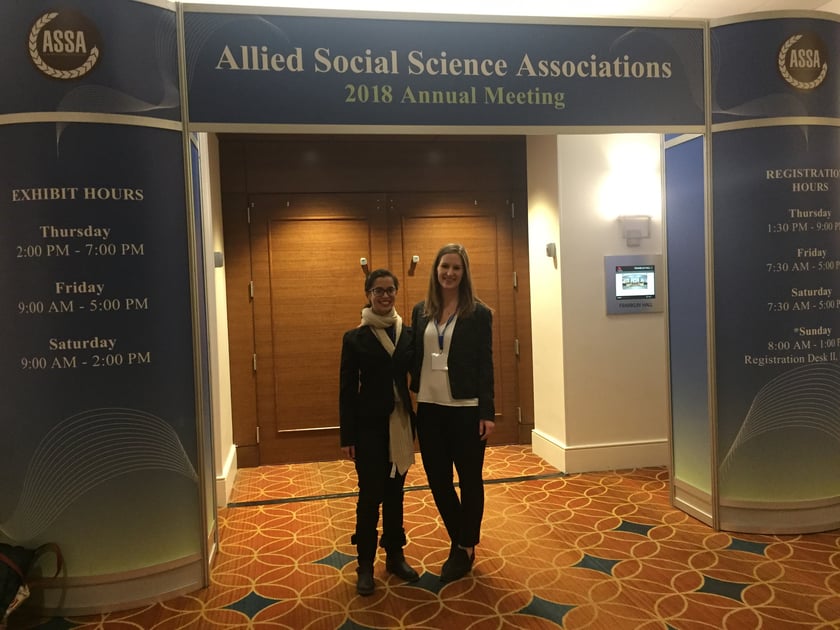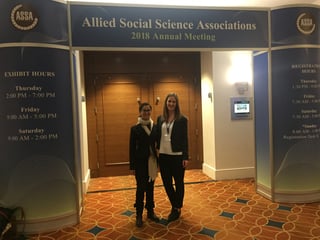Notes from the ASSA Annual Conference
January 31, 2018 •Katie Lettunich

 This blog post was written by Summit Analysts Bela Reeves and Katie Lettunich.
This blog post was written by Summit Analysts Bela Reeves and Katie Lettunich.
During the first weekend in January 2018, Summit's Dr. Albert Lee, Dr. Eddie Seiler, Bela Reeves, and Katie Lettunich made their way to chilly Philadelphia for the Allied Social Science Association's (ASSA) Annual Conference Meeting. This conference, sponsored by the American Economic Association (AEA), drew over 10,000 economists from across the globe. Summit staff connected with other economic professionals who perform rigorous analysis in the fields such as structured finance and labor discrimination.
Pay Equity
As Summit takes on new casework associated with firm-level pay equity analytics, sessions about pay equity were a point of focus for Summit’s attendees. A session chaired by Professor Samuel L. Myers Jr. examined the potential biases in measurement of wage inequality. In “Are Blacks Lazy?”, Professor William Darity and colleagues rebutted a recent NBER Working Paper that found "minorities, especially [male minorities], spend a greater fraction of their workdays not working."Professor Darity and his colleagues concluded that the initial paper skirted over basic data quality measures, such as controlling for upward biases in self-reporting, highly-unionized states, and involuntary non-work activities. They went on to argue that even implementing the most rudimentary quality control measures yielded much less startling results.
This session reinforced the importance of quality control measures when interpreting survey response data, a practice in which Summit is well-versed. At Summit, the first focus of any analysis is the thorough vetting of data, not only to make sure the data is clean and usable, but also to preemptively resolve data integrity concerns. See the following for an example case study.
In a recent blog, Summit’s Dr. Shane Thompson discussed the process of controlling for factors such as labor level in order to isolate the factors attributed to unequal and unfair pay. This conversation fits in well with the large volume of papers focusing on pay inequity based on gender and race that were discussed at the conference.
Housing & Labor, Consumer Debt
With total student loan, automobile, and credit card debt ballooning, litigators, economists, and consumers are turning their attention to the consequences and causes of debt burdens. During his presentation of "Debt and Human Capital: Evidence from Student Loans", Professor Slava Fos argued that the higher an undergraduate's student loan debt level, the less likely they are to pursue graduate studies. Rising debt and defaults present opportunities for class-action litigation against predatory lenders. At Summit, we have a longstanding history of helping organizations protect vulnerable populations. Three case studies follow: Case 1, Case 2, and Case 3. So, Summit is paying attention, and determining how best we can help.
Conclusion
Annual conferences like the ASSA showcase innovations in statistical methods and analytics. Summit attends the ASSA (and other top conferences) every year to ensure that the litigation analytics we provide and the business intelligence tools we produce are current and relevant. This year, Summit comes away from the ASSA meetings with even sharper pay equity analysis tools and loan assessment products, having made new professional acquaintances and connected with longstanding collaborators.
Get Updates
Featured Articles
Categories
- affordable housing (12)
- agile (3)
- AI (4)
- budget (3)
- change management (1)
- climate resilience (5)
- cloud computing (2)
- company announcements (15)
- consumer protection (3)
- COVID-19 (7)
- data analytics (82)
- data science (1)
- executive branch (4)
- fair lending (13)
- federal credit (36)
- federal finance (7)
- federal loans (7)
- federal register (2)
- financial institutions (1)
- Form 5500 (5)
- grants (1)
- healthcare (17)
- impact investing (12)
- infrastructure (13)
- LIBOR (4)
- litigation (8)
- machine learning (2)
- mechanical turk (3)
- mission-oriented finance (7)
- modeling (9)
- mortgage finance (10)
- office culture (26)
- opioid crisis (5)
- Opportunity Finance Network (4)
- opportunity zones (12)
- partnership (15)
- pay equity (5)
- predictive analytics (15)
- press coverage (3)
- program and business modernization (7)
- program evaluation (29)
- racial and social justice (8)
- real estate (2)
- risk management (10)
- rural communities (9)
- series - loan monitoring and AI (4)
- series - transforming federal lending (3)
- strength in numbers series (9)
- summer interns (7)
- taxes (7)
- thought leadership (4)
- white paper (15)


